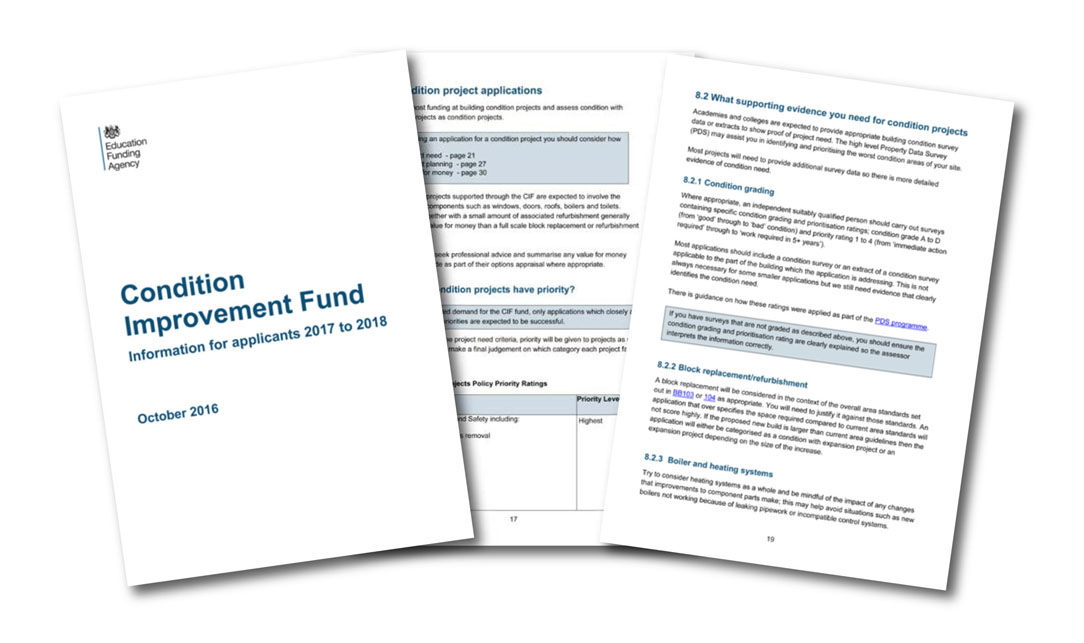
Michael Farmer, Head of Technical at 361 Degrees, discusses how local authorities and schools can create a better learning environment with the help of the Condition Improvement Fund.
Hundreds of academies and sixth-form colleges in the UK are preparing to start work on improving their facilities thanks to the Condition Improvement Fund (CIF). The latest round of funding, announced in April, provided £466m to nearly 1,200 schools and colleges.
‘Condition improvement’ is a broad term, so schools can apply for assistance with a wide range of projects. Priority is usually given to those that address safety concerns, such as asbestos removal and damaged roofs. And since schools are at risk of closure if heating systems fail, mechanical services also feature heavily.
Any financial resources awarded through the CIF are ring-fenced for specific improvement work, but they also create opportunities for savings elsewhere. Refurbishment work, such as new windows and better insulation, can cut energy bills immediately, while new technology makes it feasible for schools to include renewable energy in their upgrades.
Applying for funding
The CIF is controlled by the Government’s Education and Skills Funding Agency (ESFA). Schools in need of financial assistance submit applications through an online portal, and these applications are assessed against several criteria. Priority is given to projects that address safety concerns, but expansion work also features heavily.
In his recent budget statement, Chancellor Philip Hammond announced a further £216m to improve school buildings, taking total investment to ‘well over £10bn in this Parliament’. The CIF is one of the most important ways for schools and colleges to take advantage of that funding, so preparing a detailed, well-informed application is vital.
 Mechanical services provider 361 Degrees offers advice, through an infographic (shown on the left), for submitting applications and the tips include:
Mechanical services provider 361 Degrees offers advice, through an infographic (shown on the left), for submitting applications and the tips include:
- Understanding the priorities of your buildings
Many applications fail because schools do not demonstrate the necessary understanding of what a project entails and how it addresses a problem. Assessors need to see that risks are well understood and that the funding will address a genuine need — whether it’s an expansion to prevent overcrowding or the replacement of an ageing heating system. - Including detailed evidence
Assessors need to see value for money, so include quotes from contractors who fully understand the scope of your project. The maximum that can be awarded for any single project is £4m, with a minimum of £20,000 for primary and special schools and £50,000 for secondary schools and colleges. Applications are either wholly funded or rejected; so realistic (and, if possible, guaranteed) quotes are essential. - Planning and timing your submission well
The online application system opens in October and accounts must be created by November. The deadline for submission usually falls just before Christmas, with successful applicants notified in March or April. Candidates should not delay in beginning the process, though, as it takes time to arrange surveys, gather quotes and complete forms to the level of detail required to secure funding.
Safer learning environments
Around 85% of the CIF is typically granted to work that improves the condition of existing buildings, making it a key way to create a safer, more secure and more positive learning environment for pupils. An application must be submitted by a member of school staff who has experience of signing contracts with the Department for Education, which in most cases will be the Head or the School Business Manager. However, advice from a contractor with an understanding of the priorities of assessors can make all the difference.
All projects are scored against three weighted criteria, which should be reflected in the production of the supporting documents. Project need, assessed through a recent condition survey and other evidence, is worth 70%. This is where priority tends to go to issues such as gas safety, asbestos removal and heating systems. Project planning, where assessors look for evidence that solutions are appropriate and feasible, is worth 15% of the weighting, as is evidence that the project represents value for money.
Checklist for applicants
For those planning major upgrade work, 361 Degrees provides a four-step checklist to get started:
- Refer to the ESFA’s Information for Applicants Guide to confirm whether your project is eligible for funding
- For all the reasons explained above, establish a thorough understanding of your project and the assessment criteria
- Contact your local authority, as planning permission may be needed before work gets underway, particularly in the case of an expansion
- Gain access to the CIF portal for the relevant members of school staff
This year 1,435 funded projects were funded, but these were spread across fewer than 1,200 schools. Submissions for multiple pieces of work can therefore be successful, but each will be assessed separately and independently. The ESFA offers an appeal process for unsuccessful applicants, but only information included in the original application is considered.








